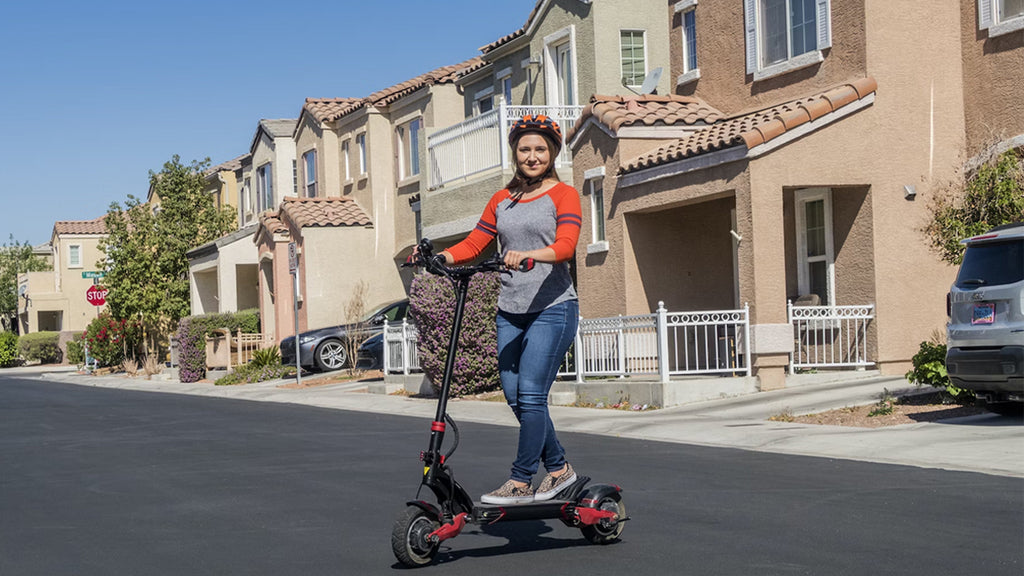The growing senior population has led to an increase in electric mobility devices that promote independence and an active lifestyle. Two popular options for seniors are electric mobility scooters and electric trikes.
But how does one choose between them? This comprehensive guide examines the key differences between electric scooters and trikes across factors like purpose, speed, terrain adaptability, portability, costs, and safety.
| Features | Electric Mobility Scooters | Electric Trikes |
|---|---|---|
| Purpose | Best for local errands | Best for longer adventures |
| Speed | Top speeds of 4-8 mph | Top speeds of 10-20+ mph |
| Terrain Suitability | Best on flat, paved surfaces | Adaptable to various terrains |
| Portability and Storage | Portable and easy to store | Less portable and requires more storage space |
| Cost | Range from $600-$5000 | Range from $500-$2000+, Mooncool audlt e-trike start from $999. |
| Safety Features | Stability, swivel seats, grab handles, large tires, adjustable speed throttles, reliable brakes, headlights | Stability, wide tires with suspension, adjustable seating positions, motor-assisted brakes, integrated lighting |
Understanding the Purpose
Electric mobility scooters provide a seated option for seniors who need a little motorized assistance getting around. The small wheels, baseboard, and adjustable tiller steering make them ideal for paved surfaces at slower speeds. Common uses include leisurely rides around the neighborhood, trips to the park or market, and mobility within airports or malls. For seniors with limited mobility or concerns about stability, a scooter delivers an easy, comfortable cruising experience.
Meanwhile, electric trikes offer seniors the option to "cycle" without the need to balance. The three-wheeled stability paired with electric pedal assist makes it possible to move at faster speeds with less effort. The open-frame design also allows seniors to engage more with the riding experience. Trikes enable longer excursions to visit friends or go sightseeing, provide exercise benefits from pedaling, and work well on both paved and hard-packed dirt trails. The tricycle configuration suits more active seniors looking for fresh air and adventures.
When it comes to purpose, mobility scooters simplify getting around closer to home on flat, paved terrain. Trikes open possibilities for longer recreational rides and terrain versatility. Those wanting a joyride feel may lean toward a trike, while seniors focused purely on functional mobility may prefer a scooter.
Read more here: How Our Electric Tricycles Are Shaping Better Lifestyles for the Elderly.
Comparing Range and Speed
When evaluating electric mobility options, range and speed are important considerations for seniors. Having confidence you can complete needed errands or enjoy lengthy recreational rides without the battery prematurely dying is crucial.
Most electric mobility scooters have a limited range of just 8-25 miles before requiring recharging. Their top speeds max out around 4-8 mph. While the range may suffice for quick trips to the market or pharmacy, longer excursions will have seniors anxiously monitoring the battery level. And the low top speeds, while stable, mean getting around town takes more time.
Read more: What's The Range Of A Mobility Scooter?
Conversely, electric trikes truly open up seniors' range and speed possibilities. A single charge enables 20-40+ miles depending on the motor and battery performance. This allows for full days of riding to visit friends, go sightseeing, or enjoy nature without range anxiety. The pedal-assist configuration also kicks top speeds up to a brisk 10-20+ mph. With speeds resembling a comfortable bike pace, seniors can cover more ground and spend less time enroute.
For seniors focused on neighborhood errands, a mobility scooter's limited range and speed may suffice. But those wanting the freedom for lengthy adventures and expedited travel will find trikes better suited to their needs. The extended range and quicker speeds ensure seniors can ride as far as they please while making the most of their time.
Evaluating Terrain and Location Suitability
Mobility scooters excel on flat, paved areas like sidewalks, roads, parking lots, and indoor surfaces. The low center of gravity and compact wheelbase ensure stability. However, the small wheels struggle on uneven terrain. Scooters lack off-road capabilities and may falter in grass, gravel, or hills. Navigating inclines or dirt trails is difficult.
Conversely, electric trikes are highly adaptable. Wider tires and adjustable suspensions allow riding on paved roads, hard-packed dirt trails, grass, gravel, and small hills with confidence. The three wheels and upright pedaling position also provide stability on uneven ground. While not full-fledged mountain bikes, trikes grant seniors much more flexibility across locations and terrains.
When choosing between the two, those who primarily need mobility across paved, indoor areas will do well with a scooter. But active seniors wanting to also explore parks, nature trails, and recreational paths will benefit from the terrain versatility of a trike.
Portability and Storage: Scooter vs. Trike
One advantage of mobility scooters is their easy disassembly for transport and storage. Many models allow you to quickly fold the tiller and separate the batteries to easily place the lightweight pieces into a car trunk. The compact nature also makes storing a scooter at home straightforward.
While some folding electric trike options exist, many trikes are not designed to fold down for storage. However, some trikes utilize lightweight aluminum frames to keep the overall weight manageable. Transporting still requires a bike rack on your vehicle though. At home, the larger footprint means most trikes need to be parked in a garage or shed.
So while not as inherently portable as folding scooters, some trikes can still be relatively lightweight for their size. But in general, electric scooters are simpler options for seniors needing to frequently transport their mobility devices or having very limited residential storage space. Trikes work best when able to be stationed at home between rides. Evaluating portability considerations based on your specific transportation and storage needs can help inform which mobility device fits best.
Explore further: How to Transport an Electric Trike Using a Carrier Trailer/Ramp.
Cost Analysis
Affordability is often a prime consideration for seniors on fixed incomes. Basic electric mobility scooters cost between $600-$4000 based on features. Quality models with seats, suspension, and extended range run $2500-$5000. With low maintenance costs, a value scooter can serve seniors for years at a moderate upfront price.
Discover more: HOW MUCH DOES IT COST TO BUY A MOBILITY SCOOTER?
However, some electric trikes can also represent an affordable mobility option for seniors. Basic models start as low as $500, while premium trikes with robust features run $2000+. So while the cycling components can require more annual maintenance than a scooter, some trikes can still be purchased for comparable or lower costs. Factoring in added expenses like helmets and accessories is recommended too.
In summary, quality mobility scooters are found in the affordable $2000-$5000 range based on desired features like range and suspension. Electric trikes can also be purchased by seniors on budgets for as little as $500-$2000. While the cycling components may demand more regular maintenance, the upfront cost of some trikes can be on par with or below scooters. Evaluating all pricing factors will help determine the most cost-effective mobility device based on a senior's budget.
To access more detailed information, click here: Drive Less, Save More: How E-Trikes Are Benefiting Families.
Safety Features Face-off

Safety is a top priority for seniors choosing a mobility device. Mobility scooters emphasize stability through three or four-wheel configurations with low centers of gravity. Swivel seats and grab handles also make getting on and off smooth. Large, low-pressure tires coupled with adjustable speed throttles, reliable brakes, and headlights maximize control, comfort, and visibility on paved surfaces. These design elements allow seniors to maintain stability and feel secure.
Electric trikes also integrate key features for senior safety. The tricycle configuration grants stability, while wide tires with suspension provide traction across varied terrain. Adjustable, upright seating positions encourage proper posture and visibility. Motor-assisted brakes and integrated lighting add control. Some include rearview mirrors to aid in monitoring surroundings. While more agile than scooters, trikes allow alert seniors to confidently navigate at faster speeds.
Both mobility devices utilize design elements like seating adjustments, lighting, tire traction, and braking systems to maximize stability, comfort, and ease of use for seniors. Scooters simplify control for those wanting an easier learning curve. But trikes provide added independence for active seniors up for more versatile riding. Test drives can help gauge comfort levels. The ideal option promotes safety while enabling the mobility and adventure desired.
Click for in-depth content: Stay Active with E-Trikes: Gentle on Knees and Joints for Seniors' Fitness.
Conclusion
In comparing electric mobility scooters and electric trikes for seniors, there are clear tradeoffs in terms of purpose, speed, terrain suitability, portability, costs, and safety considerations. Scooters offer stability for local errands while trikes empower longer adventures. Storage and price also differ. At its core, the choice depends on the senior's needs and intended use. Active seniors wanting recreation and exercise capabilities may find trikes more fulfilling. Those solely needing mobility assistance could better utilize a scooter.
By understanding the key factors, seniors can decide which device best enables the lifestyle envisioned. The goal for both is maintaining independence and enjoying life.
















Leave a Comment
This site is protected by hCaptcha and the hCaptcha Privacy Policy and Terms of Service apply.